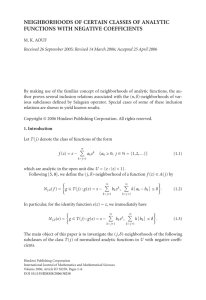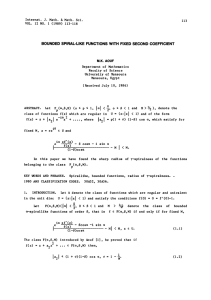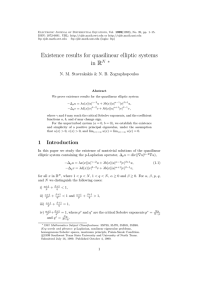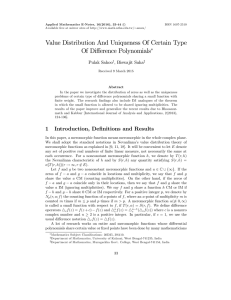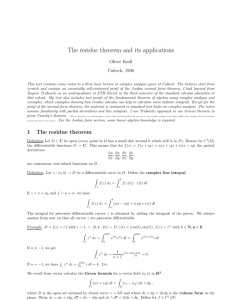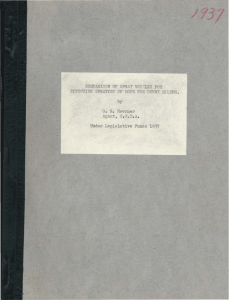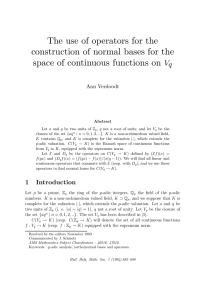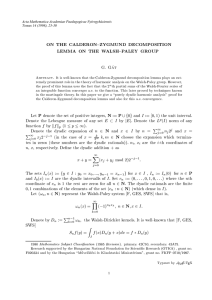HP
advertisement
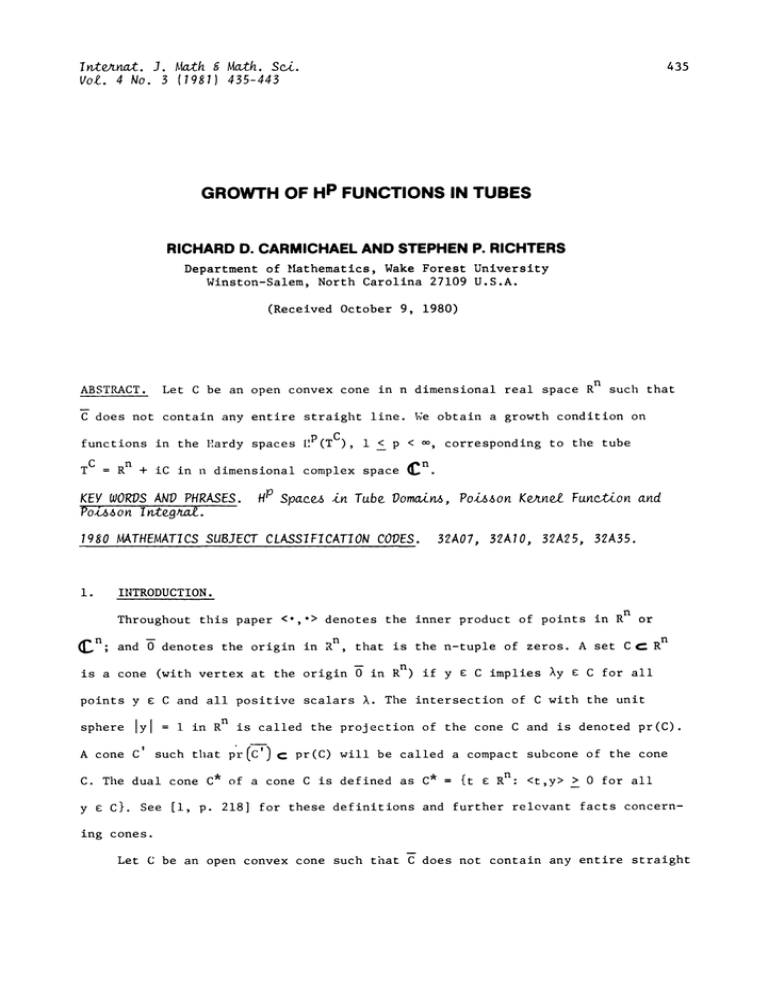
I ntern. J. Math & Math. Sci.
Vol. 4 No. 3 (1981)435-443
435
GROWTH OF HP FUNCTIONS IN TUBES
RICHARD D. CARMICHAEL AND STEPHEN P. RICHTERS
Department of Mathematics, Wake Forest University
Winston-Salem, North Carolina 27109 U.S.A.
(Received October 9, 1980)
ABSTRACT.
n
Let C be an open convex cone in n dimensional real space R
such that
C does not contain any entire straight line. We obtain a growth condition on
functions in the Hardy spaces
T
C
n
+
R
[lP(TC),
I
<_
p < oo, corresponding to the tube
n.
iC in n dimensional complex space
KEY WORDS AND PHRASES.
Hp Spaces in Tube Domains, Poisson Kernel Function and
Poisson Integral.
1980 MATHEMATICS SUBJECT CLASSIFICATION CODES.
INTRODUCTION.
i.
Throughout this paper <
n
> denotes the inner product of points in Rn or
n,
and 0 denotes the origin in R
is a cone (with vertex at the origin
points y
sphere
IYl
A cone
C’
g
n
that is the n-tuple of zeros. A set C R
n)
in R
C implies
if y
%y
g
C for all
C and all positive scalars %. The intersection of C with the unit
i in R
such that
C. The dual cone
y
32A07, 2A10, 32A25, 2A35.
C*
n
is called the projection of the cone C and is denoted
p’rI) C
Dr(C).
pr(C) will be called a compact subcone of the cone
of a cone C is defined as
C*
t
n
R
<t,y> > 0 for all
C}. See [i, p. 218] for these definitions and further relevant facts concern-
ing cones.
Let C be an open convex cone such that C does not contain any entire straight
436
R.D. CARMICHAEL and S.P. RICHTERS
line. Then
C*
has a nonvoid interior [i, p. 222, Lemma i and line 15] in R
n.
(Hence C is a regular cone in the sense of [2, p. 275] and [3, p. i01].) This fact
together with the first conclusion of [4, Lemma i] and a computation as in [4,(6)]
show that for each y E C and any p > 0 there is a
Y
> 0 depending on y
C
g
such that
IC
<
0
*
e-p<y,r]> dN
[
<
e
-p6lylInl
<
dn
C*
an
(p6lyl) -n
(n-l)!
for any cone C satisfying the above assumptions, a fact which is important for
this paper. Here
is the surface area of the unit sphere in R
n
word "volume" in
[4, p. 577,
n.
(Note that the
18] should be replaced by "surface
lines ii and
area".
Let the cone C satisfy the assumptions of the preceding paragraph. The Cauchy
kernel function corresponding to the tube T
K(z-t)
e
2gi<z-t, N>
C*
C
dN
n
R + iC is ([5, p. 201], [6])
C
z g T
The Poisson kernel function corresponding to T
IK(z-t)12
K(z-t) K(z-t)
K(2iy)
Q(z;t)
C
is
z
K(2iy)
n
t g R
([5, p. 204, (18)], [6])
C
x+iy g T
n
t E R
Both K(z-t) and Q(z’t) are well defined and satisfy various properties ([5], [6].)
For our purposes here we note that Q(z;t) is an approximate identity ([2, Prop. 2],
[5, Lemma 6]) and
0
<
satisfies
K(z-t)
Q(z;t)
12
<
K(2iy)
(K(iy))
K(2iy)
2
z
x+iy
rC
t
n
R
(i.i)
with the second inequality following directly from the definition of K(z-t).
The Hardy spaces
n
are defined in
HP(C)
0 < p <
[2] and [3, pp. 90
bounded holomorphic functions in T
Let C
HP(TCI),
I
{y
0 < p <
R
=,
n
yj
> 0, j
corresponding to a tube T
91]. Note that
H(T C)
C
R
n
+
iC in
is the space of all
C.
i
}. Madych [7] has proved that
if f(z)
then there exists a constant M(f) depending on f such that
GROWTH OF H
p
n
If(x+iy)
< M(f)
4 37
FUNCTIONS IN TUBES
N
j=l
yj)
-i/p
x+iy E T
z
CI
(1.2)
HP(T C)
In this note we prove a growth result for functions f(z)
for certain
values of p and for a general class of cones C. Our result is as follows.
n
THEOREM. Let C be any open convex cone in R
any entire straight line. Let f(z) E
C’
of C there exists a constant
If(x+iy)
<
HP(T C),
such that C does not contain
i < p < =. For any compact subcone
M(f;C’)
depending on f and on
M(f;C
lyl -n/p
In the special case of the THEOREM that C
z
C
I
x+iy E
C’
C’
T
such that
(i.3)
Madych’s growth (1.2)
better than (1.3) in that (1.2) holds for all points in the tube T
special case of the result (1.2) is if n
plane in
I;
i in which case T
CI
CI
Of course a
is the upper half
and the growth (1.2) holds also for the lower half plane in
with y replaced by
IYl
in
is
i
(1.2). For arbitrary cones satisfying the hypotheses of
C’
the THEOREM we are able to obtain (1.3) holding for all z g T
C’
being an
arbitrary compact subcone of C; and our THEOREM has interest for dimension n > 2
since the growth of H
in
i
p
functions corresponding to the upper and lower half planes
is already known as noted above. Note that at least for the case p
the hypothesis on
in the THEOREM is needed to ensure that H
function that is not identically zero on T
C
2(T C)
2,
contains a
[3, p. 94, Corollary 2.6], and
wQ
further need this assumption for all p, i < p < =, in order to have Q(z;t) well
defined in our proof of the THEOREM which is given in section 2 of this paper.
Because of [3, p. 93, Corollary 2.4] there is no loss of generality in letting
the cone C be convex in the THEOREM for p
2; we assume C is convex for the
lP(TO(C)), O(C) being
the convex envelope o’f the assumed open and connected cone C. HOO(T C) is by
definition the space of all bounded holomorphic functions in TC; hence we did
not include the case p
in the THEOREM since the growth of HO(TC) functions
other p also for otherwise we would prove the THEOREM for
is known by definition.
In [4] we obtained the THEOREM for the case p
2 using analysis involving
GROWTH OF H
438
p
FUNCTIONS IN TUBES
H2(TC). In this
HP(TC), 1 <_ p < ,
HP(TC). The growth
the Cauchy integral representation of functions in
note we are
able to extend this growth result to the spaces
using the
Poisson integral representation of functions in
(1.3) is of
independent interest, but we are especially interested in it because it aids us
in analysis relating certain spaces of holomorphic functions in tubes having
distributional boundary values with H
p
spaces in tubes, a topic of research which
has proved useful in mathematical physics and which we are presently pursuing.
2.
PROOF OF THE THEOREM.
We prove the THEOREM with the aid of two lemmas. Throughout this section
n
and v E R
denotes the angle between the two nonzero vectors u E R
n
Bu,v
with this
angle being defined in the usual way.
LEMMA i. Let the cone C be as in the THEOREM. Let C
subcone of C. There exists a constant
A(C’) depending
_< A(C’) lyl
K(iy)
-n
be an arbitrary compact
C’
on
such that
C’.
y
(2.1)
We give two proofs of Lemma i.
FIRST PROOF OF LEM i. For any compact subcone
C’
depending on
such that 0 < y
<
Yo
where
inf
o
{B
u,v
C’
of C choose an angle
Yo
< /4 and
u g
C pr(C)
C (C’) denotes the boundary of C (C’);
C’
v
exists Let y g
Yo
and
pr(C’)}
C’
be
arbitrary and put
Fy,yo
Then y
F
F
Y’Yo
the choice of
C’C
K(iy)
e
R
n #
0
0
!
Bn y, < yo
n,
is an open convex cone in R
and
F
Y’Yo
hence the corresponding dual cones satisfy
Yo
for the y g
Y’Yo
n
{n
C*
C C because of
C
F*
Y’Yo
Thus
C
-2<y N>
dq <
C*
r*
I
Y’Yo
e
-2<y q> dq
r*
I
Y’Yo
e
-2<y,q>
(22)
",,
(The first equality in (2.2) is the definition of the Cauchy kernel K(iy), y
C.)
GROWTH OF H
p
439
FUNCTIONS IN TUBES
We switch to n dimensional spherical coordinates ([8, pp. 217
218], [9]) by
letting
r
n
Inl
where r
(2.3)
and
(2.4)
(cos(e
I
sin(el)...sin(en_2)coS(Sn_l) ,sin(el)...sin(en_2)sin(@n_ I))
,sin(81)cos(82)
with n being the dimension; and
0 < 0. < z
n-2,
i
j
(2.5)
0<8
n-i
<2.
Put
’
{(81 82
8
n
r
q
i):
e
F*
Y’Yo
{0},
0 < r < oo}
Noting the Jacobian of the transformation (2.3) in [8, p. 218] we obtain from
(2.2) that
<_
K(iy)
e
r*
Y’Yo
I 0
for y g
so that
C’
r
-2<y D> dq
\{o}
n-i
e
(2.6)
-2r<y
>
sin
n-2
(e l) sin
n- 3
F
C C. It follows from the definition of
r<y,>
<y,q>
<
0
<
lyl
Inlco(Sn,y
6rl
(1T/2)
(82)...sin(On_ 2)
Y’Yo
-Yo
<
dr
dOl...d0n_ I
that for any q g
*Y’Yo {}
1T/2
(2.7)
> 0 in the right side of (2.6). Thus
integration by parts (n-l) times on the improper integral with respect to r in
(2.6) yields
r
n-i
e
-2r<y,>
(n-l)
dr
(2.8)
(2<y,>)
The
defined in (2.4) satisfies
varies over
pr(*
Y’Yo
I[
and from (2.7)
I. As q
0
<_
r
6,y_<
varies over
(/2)
Yo
F*
Y’Yo
{5},
< /2 so that
440
R.D. CARMICHAEL and S.P. RICHTERS
cos(By,y)
in
> cos((/2)
yo
<y,>
> O. Thus
in the right side of
(2.6), and hence
(2.8), satisfies
lyllIcos(B,y)= lylcos(,y
<y,>
>
lylcos((/2)
yo
(2.9)
> 0
Using (2.9) and (2.8) in (2.6), we have
K(iy) <
(2ly
C’
for y
cos((/2)-
’
n
sln
(0 I) sin
and indeed over the whole of
n-2, 0 <
i,
yo))
(2.10)
n-2
n- 3
(02)...sin(0n_ 2) d01...d0n_ I
C C. From (2.5) we see that the integrand in (2.10) is a nonnegative
function over
j
I’
(n-l)!
en-i < 2};
number. Thus we replace
’
’’
{(01,02
0n_l):
0 <
ej
<
,
and the integral in (2.10) is a finite positive real
in (2.10) by
’’
and obtain
A(C’)lyl -n
K(iy)
<
yo ))n
I,,
(2.11)
where
(n-l)
(2 cos((/2)
A(C’)
sin
n-2
(
i
sinn- 3 (@2)..-sin(@n_2) d@l.-.den_ I
and the integral on the right is a finite positive real number. This constant
depends on
C’
depends on
C’.
C’
C’
y
with
since the choice of the angle
However, A(C’) does
Yo
A(C’)
at the beginning of the proof
not depend on y
C’;
(2.11) holds for all
being any compact subcone of C. Thus (2.1) is obtained, and the
first proof of Lemma i is complete.
SECOND PROOF OF LEMMA I. Let
C’
be an arbitrary compact subcone contained in
(C’) >
C. By the second conclusion of [4, Lemma i] there exists a
only on
C’
such that <y,> >
IYl DI
for all y E
inequality and the same calculation as in
K (iy)
d <
e
C*
for all y
n-I e
n
r
C’
C C, where
e
C*
dr
n
C’
C*.
and all
0 depending
This
[4, (6)] yield
dD <
n
e
d
R
n (n-l)’.
(2lyl) -n
n.
is the surface area of the unit sphere in R
(As
p
GROWTH OF H
441
FUNCTIONS IN TUBES
noted in the second paragraph of the Introduction, the word "volume" in
[4, p. 577, lines ii and 18] should be replaced by "surface area".) Thus (2.1)
is
again proved with
A(C’)
C’
depending on
C C since
n
depends on
(2) -n
(n-l)
C’.
The second proof of Lemma I is complete.
LEMMA 2. Let the cone C be as in the THEOREM. There exists a constant B(C)
depending on C such that
>
K(2iy)
B(C)
IYl -n
(2.12)
y E C.
PROOF. By the first conclusion of [4, Lemma i] we have that <y,> > 0 for all
C* {},
e
y E C and all
which is a nonvoid set by the discussion in the second
paragraph of the Introduction, under the assumptions on the cone C. Using this
fact, a change to spherical coordinates in n dimensions as in the first proof of
Lemma 1, and-a computation as in (2.8), we obtain for all y E C that
K(2iy)
e
-4<y
>
C*
e
d
s
inn-2 (81
pr(C*)
0
<
(2.13)
sinn-3(82)...sin(Sn_2)
<y,T> > 0 for all y
and
e
C*{},
0 < r < =}.
C. Thus for <y,T> in (2.13)
lyl I’el=os(Sy,v) <_ lyl
<y,>
dSl...dSn_ I
r
{(81,82,...,8n_i):
where T is defined in (2.4) and
E
d
C* {}
(n-l)
n
(4)
In (2.13)
-4<y, >
c.
y e
(2.14)
Using (2.14) in (2.13) we get for any y E C that
K(2iy)
>
(n-1)’.
(4lyl)n
I
slnn-2(8 i s inn-3 (8)
2
sin(Sn
2
dSl dSn
i
(2.15)
The integral on the right of (2.15) is a finite positive real number, and (2.15)
holds for all y E C.. Further the integral in (2.15) depends only on the cone C
since
depends only on
C*
which depends only on C. The integral on the right of
(2.15) is independent of y e C. (2.15) is thus the desired inequality (2.12) with
B(C)
(n-l)!
(4)-n
sinn-2(81
The proof of Lemma 2 is complete.
n- 3
s in
(82)’’’sln(Sn-2) d81
dSn_ 1
R.D. CARMICHAEL and S. P. RICHTERS
442
PROOF OF THE THEOREM
By [2, Prop
there is a function h E
LP(Rn)
f (z)
IR
4], given f(z)
HP(T c)
E
such that
n
h(t) Q(z;t) dt
z E T
C.
Using this equality, the fact that the Poisson kernel Q(z;t)
an approximate identity ([2, Prop. 2],
[I0, p. 91, 2.4 19]
If (x+iy)
and (i i)
P
i < p <
n,
C
t E R
is
[5, Lemma 6]), Jensen’s inequality
we obtain for z
h(t) Q(z;t)
z e T
dtJ p
C
x+iy E T
that
<
(2.16)
<
Now let
C’
I
Jh(t) JP
n
R
I
(K(iy))2
<
Q(z;t) dt
K(2iy)
IN(t) Ip
n
dt
R
be an arbitrary compact subcone of C. Using Lemmas i and 2 in (2.16) we
obtain constants
A(C’)
f (x+iy) P
and B(C) such that
<
(A(C’))
jy]-n
I
n
Jh(t)l p
z
dt
x+iy
T
C’.
(2.17)
R
The desired growth (1.3) with
LP
now follows by taking-the pth. root of both sides of (2.17). The proof of the
THEOREM is complete.
REFERENCES
Man.
i.
VLADIMIROV, V. S. Methods of the Theory of Function.s of
Variables, M. I. T. Press, Cambridge, Mass., 1966.
2.
KORANYI, A. A Poisson Integral for Homogeneous Wedge Domains,
J. Analyse Math. 14 (1965) 275- 284.
3.
STEIN, E. M. and G.
4.
CARMICHAEL, Richard D. and Elmer K. HAYASHI. A Pointwise Growth Estimate
for Analytic Functions in Tubes, Internat. J. Math. Math. Sci. 3
581.
(1980) 575
5.
CARMICHAEL, Richard D. Generalized Caudhy and Polsson Integrals and
Distributional Boundary Values, SIAM J. Math. Anal. 4 (1973) 198- 219.
Complex
WEI.SS. Introduction to Fourier Analysis on Euclidean
Spaces, Princeton University Press, Princeton, N. J., 1971.
GROWTH OF H
p
FUNCTIONS IN TUBES
443
6.
CARMICHAEL, Richard D. and Elmer K. HAYASHI. Analytic Functions in Tubes
Which Are Representable by Fourier-Laplace Integrals, Pacific J. Math.
61.
90 (1980) 51
7.
MADYCH, W. R. Distributions with Strong Maximal
Functions in
LP(Rn),
preprint.
8.
FLEMING, Wendell. Functions of Sever.al
Springer-Verlag, New York, 1977.
9.
BLUMENSON, L. E. A Derivation of n-dimensional Spherical Coordinates,
Amer. Math. Monthly 6__7 (1960) 63- 66.
i0.
FEDERER, Herbert. Geometric Measure Theory, Springer-Verlag, New York, 1969.
Variablesr
2nd Edition,
